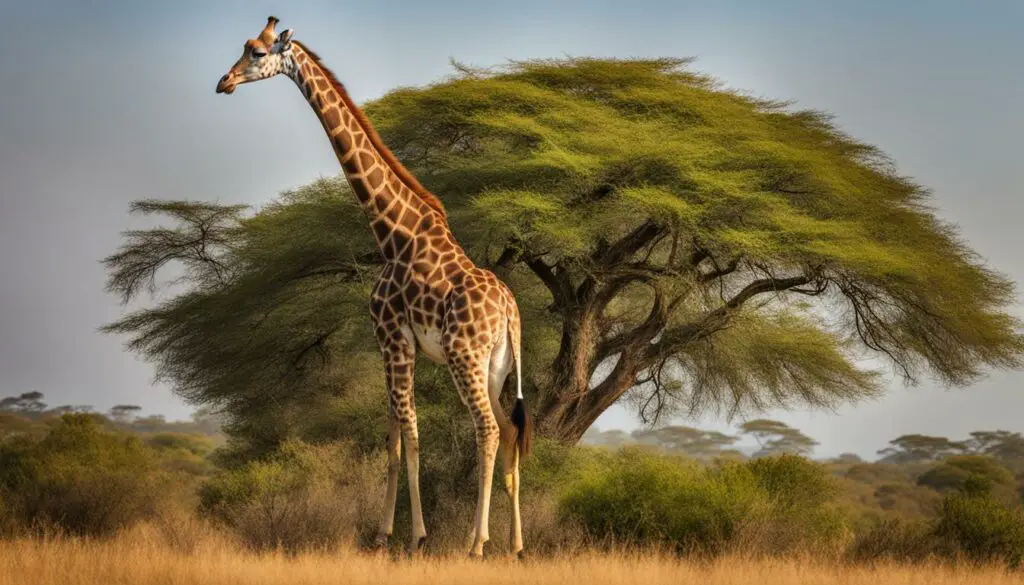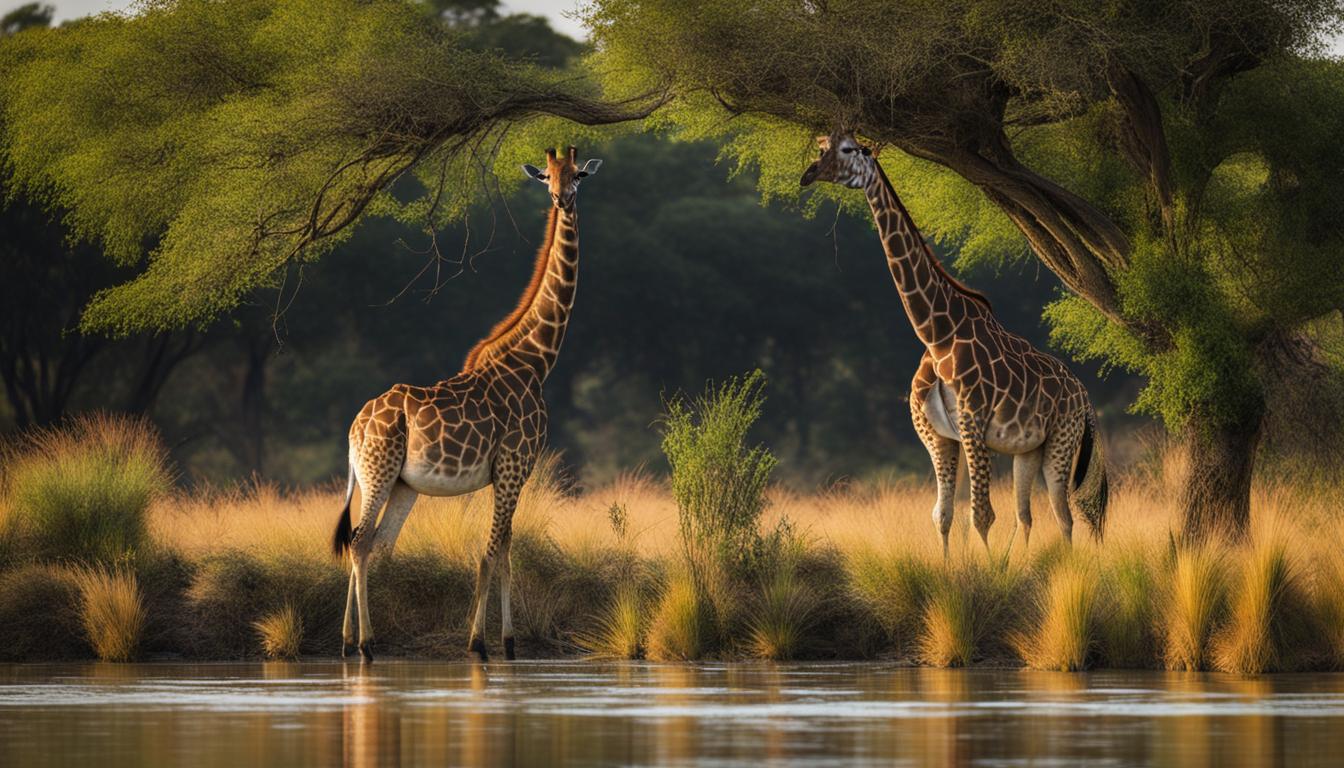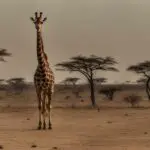Welcome to our article on giraffe feeding habits! If you’ve ever wondered what giraffes eat and how they go about their meals, you’ve come to the right place. Giraffes, majestic creatures with their long necks, have a unique diet and feeding behavior that sets them apart from other animals.
Giraffes are herbivores, which means they rely solely on plants for their nutrition. Their diet primarily consists of vegetation such as leaves, twigs, fruits, and seeds. Their long necks come in handy when it comes to accessing high tree branches, where they prefer to find their food. This behavior is known as browsing, and it allows giraffes to feast on leaves that other animals can’t reach.
Another interesting aspect of giraffe feeding behavior is their unique chewing process. After initially chewing their food, they regurgitate it and re-chew it. This helps with digestion and nutrient absorption.
So, what do wild giraffes eat? Well, their food choices can vary depending on the season and availability. They have preferences for certain plants like acacia, herbs, fruits, and leaves of various species. On average, giraffes consume between 34 and 75 kilograms of vegetation daily!
Stay tuned for the next sections of our article, where we’ll dive deeper into giraffe food preferences, feeding patterns, their diet in different seasons, and more. You’ll gain a comprehensive understanding of these gentle giants and their fascinating eating habits.
Giraffes’ Favorite Food: Acacia and Other Plants
Giraffes have a diverse diet that includes a range of plants, but one of their favorite foods is acacia. Acacia trees and shrubs are abundant in the giraffe’s environment, making them easily accessible and a preferred choice. These tall mammals also consume leaves, twigs, fruits, and seeds from over 100 different plant species. Their food preferences vary depending on the season and availability of vegetation.
What sets giraffes apart from other herbivores is their adaptation to eat thorny acacia leaves without injuring themselves. Their long, sticky tongues and cushioned mouths protect them from the sharp elements of trees and shrubs. Furthermore, when under stress, giraffes have been observed to consume bark from branches, and some individuals even lick bone remains and chew dry bones for their high calcium content.
Giraffes’ ability to feed on a wide variety of plants, including acacia, plays a crucial role in their survival and ecological impact. By consuming plants that other animals cannot reach, they contribute to the balance of their ecosystem.
Giraffe Feeding Patterns and Adaptations
Giraffes have developed unique feeding patterns and adaptations that enable them to survive and thrive in their natural habitats. These fascinating creatures are ruminant animals, which means they have a specialized stomach consisting of four parts. This allows them to digest their food in a different manner than other mammals.
When it comes to feeding, giraffes have a distinctive process. They start by chewing their food for a short period of time before swallowing it. After swallowing, they then regurgitate the food and chew it again in what is known as “cud.” This prolonged chewing helps break down the vegetation into smaller pieces and aids in their digestion.
Giraffes also have remarkable adaptations that allow them to consume their preferred food sources. Their long necks and tongues enable them to reach high branches and leaves, which are out of reach for most other animals. Additionally, their tongues are tough and highly dexterous, allowing them to strip leaves from branches without being affected by the thorns or sharp elements of trees and shrubs.
“The elongated neck of the giraffe is an incredible adaptation that allows them to access food sources that are otherwise inaccessible to many other herbivores,” said Dr. Jane Meadows, a wildlife biologist. “Their unique feeding behavior and adaptations have played a crucial role in their evolution and survival.”
Giraffe Neck Adaptation
One of the most remarkable aspects of giraffe feeding behavior is their neck adaptation. The long neck not only enables them to reach high branches, but it also provides a distinct advantage when it comes to water consumption. Giraffes are able to spread their front legs and bend down to reach water sources, thanks to a special structure in their neck that prevents excessive blood flow to their head. This adaptation allows giraffes to drink water without straining or experiencing discomfort.
| Feeding Patterns | Adaptations |
|---|---|
| Giraffes chew their food briefly before swallowing and regurgitate it to chew it again. | Giraffes have a complex stomach with four compartments for efficient digestion. |
| Giraffes have long necks and tongues to reach high branches and strip leaves. | Their tongues are tough and dexterous, protecting them from thorns. |
| Giraffes have a unique neck structure that allows them to drink water without discomfort. | This adaptation helps prevent excessive blood flow to the head. |

In summary, giraffes have fascinating feeding patterns and adaptations that have allowed them to thrive in their environment. From their unique chewing process to their long necks and tough tongues, these adaptations have given giraffes the ability to access and consume vegetation that would otherwise be unreachable. The complex stomach structure and specialized neck adaptation further contribute to their efficient feeding behavior. Understanding these feeding patterns and adaptations provides valuable insight into the remarkable nature of giraffes.
Giraffe Diet in Different Seasons
Giraffes have a diverse diet that varies depending on the season and the availability of food sources. They are adaptive feeders and adjust their food choices to ensure their nutritional needs are met. Let’s take a closer look at how a giraffe’s diet changes throughout the different seasons.
Seasonal Changes in Giraffe Diet
In the rainy season, giraffes have access to a wide variety of fruits, leaves, twigs, and water sources. They take advantage of the abundance of deciduous plants during this time and incorporate them into their diet. Fruits become more prevalent as they provide a good source of nutrients and water for giraffes.
However, during the dry season when food is scarce, giraffes primarily forage for evergreen plants. They focus on consuming leaves and twigs from trees and bushes, with a particular affinity for acacia trees. These evergreen plants are essential for their survival during periods of limited food availability.
Variation in Giraffe Food Choices
Their food choices also depend on the growth stage of plants in their environment. Giraffes are selective browsers and prefer younger leaves over older ones. They may also shift their focus to different types of plants based on their nutritional needs and preferences.
Overall, the variations in giraffe diet throughout the seasons highlight their adaptability and ability to survive in different environments. By adjusting their food choices to the available vegetation, giraffes ensure their continued health and well-being.
https://www.youtube.com/watch?v=DXKe2Kpymw0
| Season | Main Food Sources |
|---|---|
| Rainy Season | Fruits, leaves, twigs, deciduous plants |
| Dry Season | Evergreen plants, acacia trees, twigs |
Giraffe Feeding Habits in Different Species and Habitats
Giraffes are fascinating creatures with diverse feeding habits that vary across different species and habitats. Understanding these habits provides valuable insights into their behavior and survival strategies. Let’s explore the types of giraffes and their specific feeding habits in various habitats.
Giraffe Species and Their Feeding Habits
Giraffes belong to different species, each with its own distinct feeding preferences. The southern giraffe, for example, primarily consumes leaves, shoots of trees, flowers, acacia bark, pods, and seeds. The Masai giraffe, on the other hand, favors the leaves of acacia trees, twigs, and seasonal fruits. Reticulated giraffes have a taste for seed pods, leaves, and fruits of specific trees such as acacia, wild apricot, and mimosa. Lastly, the northern giraffe’s diet includes shoots, grains, nuts, leaves, flowers, and fruits.
These varied feeding habits are influenced by factors such as habitat availability, climate, and the specific adaptations of each species. Giraffes have evolved to thrive in different ecosystems, adapting their feeding habits to the resources present in their surroundings.
Habitat Preferences of Giraffes
Giraffes can be found in diverse habitats, including savannahs and woodlands across various African countries. Their choice of habitat depends on factors such as food availability, water sources, and safety from predators. Each habitat offers unique vegetation that suits the feeding habits of giraffes in that region.
For example, giraffes in savannahs often have access to a wide range of plants and trees, providing them with a diverse diet throughout the year. Woodland giraffes, on the other hand, may rely more heavily on specific tree species found in those habitats. The availability of food resources in different habitats influences the feeding behavior and adaptations of giraffes within those regions.
Overall, giraffe feeding habits reflect their ability to adapt to different environments, making use of the available vegetation and resources. By studying these habits, researchers gain a deeper understanding of these magnificent creatures and the delicate balance of ecosystems they inhabit.
Giraffes in the Animal Food Chain
Giraffes occupy an important position in the animal food chain, providing sustenance for various predators. They are a valuable food source for predators such as lions, hyenas, leopards, and crocodiles. These carnivores rely on giraffes as a significant part of their diet, preying on them to fulfill their nutritional needs. The presence of giraffes in an ecosystem ensures a stable food supply for these predators, contributing to the overall balance of the animal kingdom.
Furthermore, giraffes have a symbiotic relationship with certain bird species, such as the red-billed oxpeckers. These birds feed on the ticks and parasites that inhabit the giraffe’s skin, benefiting from the giraffe’s presence by gaining nourishment while helping to keep the giraffe free from harmful parasites.
Giraffes are not only preyed upon but also offer valuable mutualistic relationships that benefit other species. They play a vital role in maintaining the delicate balance of their habitats.
In addition to their role as a food source, giraffes contribute to the dispersal of seeds and the pollination of plants in their environment. As they move through their habitat, giraffes consume various fruits and seeds, which are later expelled through their waste. This process helps to disperse seeds across different areas, aiding in the growth and survival of plant species. Furthermore, when giraffes feed on flowers and nectar-rich plants, they inadvertently transfer pollen from one plant to another, promoting cross-pollination and the production of new offspring.
The presence of giraffes in the animal food chain exemplifies their significance in maintaining a healthy ecosystem. Through their role as both prey and pollinators, giraffes contribute to the overall biodiversity and sustainability of their habitats. Understanding the intricate connections between giraffes and other species highlights the intricate web of life and the interdependence of all living organisms.
Conclusion
In summary, giraffes have unique feeding habits and adaptations that allow them to thrive on a plant-based diet. They prefer to consume leaves, twigs, fruits, and seeds of various plants, with a special affinity for acacia trees. Giraffes have a structured feeding process, including regurgitation and re-chewing of their food, to aid in digestion.
Their feeding patterns vary depending on the season and the availability of food sources. During the rainy season, giraffes have access to a variety of fruits, leaves, twigs, and water. In contrast, during the dry season, when food is scarce, they mainly forage for evergreen plants, especially acacia trees and bushes. Giraffes adjust their food choices based on the availability of vegetation and the growth stage of plants in their environment.
Giraffes play a significant role in the animal food chain. They are a direct source of nutrition for predators such as lions, hyenas, leopards, and crocodiles. Additionally, their presence in an ecosystem provides food for these predators. Giraffes also contribute to seed dispersal and pollination, indirectly benefiting the plants in their environment. Understanding giraffe feeding habits gives insight into their behavior and survival in their natural habitats.
What is the Typical Diet of Giraffes?
Giraffes’ feeding habits and typical diet are predominantly herbivorous. They rely on consuming leaves, buds, and shoots from different tree species. Their long necks allow them to reach higher vegetation that other animals can’t access. Giraffes have a specialized digestive system to break down the tough fibrous plants they consume, enabling them to extract maximum nutrients from their diet.
FAQ
What do giraffes eat?
Giraffes are herbivores and have a diet based on plants, including vegetation such as leaves, twigs, fruits, and seeds.
What is the favorite food of giraffes?
One of the favorite foods of giraffes is acacia, a genus of trees and shrubs common in their environment.
How do giraffes eat the thorny leaves of acacia trees without injuring themselves?
Giraffes use their long, sticky tongues and cushioned mouths to protect themselves from the sharp elements of trees and shrubs.
How do giraffes digest their food?
Giraffes are ruminant animals with a stomach consisting of four parts. They chew their food, swallow and regurgitate it to chew it a second time.
How much vegetation do giraffes consume each day?
Giraffes consume between 34 and 75 kg of vegetation each day.
What do giraffes eat during different seasons?
Giraffes adapt their food choices based on the availability of vegetation. During the rainy season, they have access to a variety of fruits, leaves, twigs, and water. In the dry season, they mainly forage for evergreen plants, especially acacia trees and bushes.
What are the different species of giraffes and their feeding habits?
The southern giraffe mainly eats leaves, shoots of trees, flowers, acacia bark, pods, and seeds. The Masai giraffe primarily feeds on the leaves of the acacia tree, twigs, and seasonal fruits. Reticulated giraffes feed on seed pods, leaves, and fruits of their favorite trees, which include acacia, wild apricot, and mimosa. The northern giraffe’s diet includes shoots, grains, nuts, leaves, flowers, and fruits.
What role do giraffes play in the animal food chain?
Giraffes are a direct source of nutrition for predators such as lions, hyenas, leopards, and crocodiles. They also have a mutual relationship with birds, such as red-billed oxpeckers, who feed on ticks found on the giraffe’s skin. Giraffes also contribute to seed dispersal and pollination, benefiting the plants in their environment.
What are the key points about giraffe feeding habits?
Giraffes have a plant-based diet, with a preference for acacia trees. They have unique adaptations for eating thorny leaves and a specialized chewing process. Their feeding patterns vary depending on the season and the availability of food sources. Different giraffe species have different feeding habits, and they play a vital role in the animal food chain.











